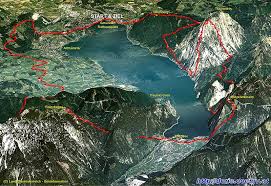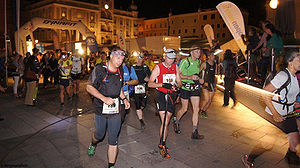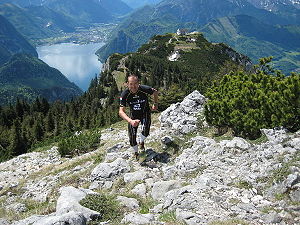Difference between revisions of "Effects of ultramarathon performance on mitochondrial respiration in human platelets - a project summary"
| Line 3: | Line 3: | ||
'''Introduction''' | '''Introduction''' | ||
Acute strenuous exercise is linked to severe inflammatory responses [1,2], alterations of mitochondrial function of human skeletal muscle and increased oxidative stress [3]. Due to the invasive nature of muscle biopsies, minimally-invasive alternatives to study mitochondrial function in tissues such as blood cells are gaining significance. Mitochondrial function in human platelets and lymphocytes has been characterized in various disease states. Importantly, respiratory capacity of human PBMCs was linked to physical fitness [4], supporting the concept that mitochondrial function in human blood cells can be used as a systemic mitochondrial marker. In this study we investigated the influence of completion of an ultramarathon on mitochondrial respiration in human platelets. | |||
'''Methods''' | '''Methods''' | ||
10 male hobby athlethes were chosen for the study and signed a written conset. 3 blood samples were taken to highlight potential influence of ultramarathon performance and time of recovery on human platelets: ~10h before competition start (PRE), ~15min after finishing (POST). Taken whole-blood samples were centrifuged immediately (15min, 300g) to gain platelet-rich plasma, which was incubated 20min before performing the second centrifugation step (1000g, 10min). Thus, pelleted platelets were resuspended in MiR05 by gentle pipetting and added to the Oroboros O2k. Cells were permeabilized to ensure access of external substrates. Following SUIT was performed: | |||
{| class="wikitable" | |||
|- | |||
| substrate || P || M || Dig || D || G || S || u || Rot || Ama | |||
|- | |||
| final conc. || 5mM || 2mM || 200µg/ml || 1mM || 5mM || 10mM || 1 µM doses up to Jmax | |||
|| 2µM || 1.25µM | |||
|- | |||
|} | |||
To ensure earliest possible sample analysis, 6 O2k were running simultaneously in the locally set-up laboratory i the municipal building of Gmunden close to the start/finish area. After respiratory analysis, samples were extracted from the O2k chambers and frozen for further analysis of protein content. Additional blood was taken to perform additional analysis (oxidative stress markers, Lymphocyte/Monocyte/Neutrophils content, Creatin Kinase, Lactate dehydrogenase, Creatinine. | |||
[[File:10.jpg|300px]] | |||
Pic. 1: O2ks at work | |||
[[File:13.jpg|300px]] | |||
Pic. 2: separating platelets by centrifugation | |||
[[File:18.jpg|300px]] | |||
Pic. 3: first discussion of results | |||
'''Competition and participants''' | '''Competition and participants''' | ||
To enhance the chance for possible effects, a rather challenging competition with a total distance of 68 kilometer and approximately 4500 meter of ascent was chosen. Having the opportunity to choose their start time unfettered between 3 and 5am in Gmunden/Austria, the course was set around the lake "Traunsee", crossing all peaks around it. | To enhance the chance for possible effects, a rather challenging competition with a total distance of 68 kilometer and approximately 4500 meter of ascent was chosen. Having the opportunity to choose their start time unfettered between 3 and 5am in Gmunden/Austria, the course was set around the lake "Traunsee", crossing all peaks around it. | ||
Being hobby athletes, participants exhibited a mean BMI of 24,9 kg/m² and an average age of 39,9 years | Being hobby athletes, participants exhibited a mean BMI of 24,9 kg/m² and an average age of 39,9 years. The average speed of 5 km/h and a heart rate of 134 bpm during the race gave rise to finish the competition in 12,9 hours, whereas individual finish times were rather divergent (min: 9,7 h; max: 16,1 h). | ||
[[File:Course.jpeg|300px]] | |||
Pic. 1: competition course | |||
[[File:Start.jpg|300px]] | |||
Pic. 2: start during the night | Pic. 2: start during the night | ||
[[File:Läufer.jpg| | [[File:Läufer.jpg|300px]] | ||
Pic. 3: somewhere on the course | Pic. 3: somewhere on the course | ||
'''preliminary results of platelet respiration''' | '''preliminary results of platelet respiration''' | ||
Revision as of 12:29, 23 September 2015
Additional see abstract of MiPconference 2015: [[1]]
Introduction
Acute strenuous exercise is linked to severe inflammatory responses [1,2], alterations of mitochondrial function of human skeletal muscle and increased oxidative stress [3]. Due to the invasive nature of muscle biopsies, minimally-invasive alternatives to study mitochondrial function in tissues such as blood cells are gaining significance. Mitochondrial function in human platelets and lymphocytes has been characterized in various disease states. Importantly, respiratory capacity of human PBMCs was linked to physical fitness [4], supporting the concept that mitochondrial function in human blood cells can be used as a systemic mitochondrial marker. In this study we investigated the influence of completion of an ultramarathon on mitochondrial respiration in human platelets.
Methods
10 male hobby athlethes were chosen for the study and signed a written conset. 3 blood samples were taken to highlight potential influence of ultramarathon performance and time of recovery on human platelets: ~10h before competition start (PRE), ~15min after finishing (POST). Taken whole-blood samples were centrifuged immediately (15min, 300g) to gain platelet-rich plasma, which was incubated 20min before performing the second centrifugation step (1000g, 10min). Thus, pelleted platelets were resuspended in MiR05 by gentle pipetting and added to the Oroboros O2k. Cells were permeabilized to ensure access of external substrates. Following SUIT was performed:
| substrate | P | M | Dig | D | G | S | u | Rot | Ama |
| final conc. | 5mM | 2mM | 200µg/ml | 1mM | 5mM | 10mM | 1 µM doses up to Jmax | 2µM | 1.25µM |
To ensure earliest possible sample analysis, 6 O2k were running simultaneously in the locally set-up laboratory i the municipal building of Gmunden close to the start/finish area. After respiratory analysis, samples were extracted from the O2k chambers and frozen for further analysis of protein content. Additional blood was taken to perform additional analysis (oxidative stress markers, Lymphocyte/Monocyte/Neutrophils content, Creatin Kinase, Lactate dehydrogenase, Creatinine.
Pic. 1: O2ks at work
Pic. 2: separating platelets by centrifugation
Pic. 3: first discussion of results
Competition and participants
To enhance the chance for possible effects, a rather challenging competition with a total distance of 68 kilometer and approximately 4500 meter of ascent was chosen. Having the opportunity to choose their start time unfettered between 3 and 5am in Gmunden/Austria, the course was set around the lake "Traunsee", crossing all peaks around it.
Being hobby athletes, participants exhibited a mean BMI of 24,9 kg/m² and an average age of 39,9 years. The average speed of 5 km/h and a heart rate of 134 bpm during the race gave rise to finish the competition in 12,9 hours, whereas individual finish times were rather divergent (min: 9,7 h; max: 16,1 h).
Pic. 1: competition course
Pic. 2: start during the night
Pic. 3: somewhere on the course
preliminary results of platelet respiration
discussion





